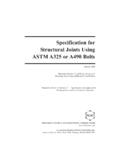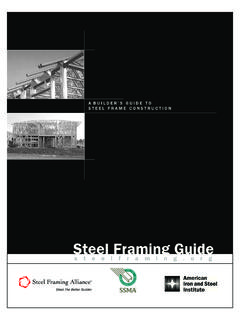Transcription of QUALIFICATION OF DACROMET FOR USE WITH …
1 IBECA. QUALIFICATION OF DACROMET FOR USE WITH ASTM A490 HIGH- STRENGTH STRUCTURAL BOLTS. AN INVESTIGATION PER IFI-144. by Salim Brahimi Eng. IBECA Technologies Corp. Montreal, Quebec CANADA. FINAL. December 13, 2006. IFI-144 QUALIFICATION of DACROMET IBECA Technologies - December, 2006. EXECUTIVE SUMMARY. ASTM A490 currently prohibits the application of metallic coatings on its high strength structural bolts. At the heart of this prohibition was the desire to institute a measure that would eliminate the risk of hydrogen embrittlement. The long term objective of this investigation was to make a case for allowing the application of a safe metallic coating on high strength structural fasteners. To achieve this, the methodology prescribed in IFI-144 was applied to qualify the DACROMET coating system for use with ASTM A490 bolts.
2 DACROMET satisfied all of the performance criteria specified in IFI-144, including paintability, coating adhesion, and rotational capacity. Continuous salt spray and cyclic exposure demonstrated that DACROMET has significantly superior corrosion protection capabilities in comparison with hot dip galvanizing and mechanical galvanizing. Process QUALIFICATION results and product testing results demonstrated that DACROMET . does not cause internal hydrogen embrittlement (IHE), nor does it promote environmental hydrogen embrittlement (EHE) when used on ASTM A490 bolts. Finally, the investigation demonstrated that IFI-144 can serve as an effective testing roadmap for qualifying metallic coatings for use with high strength structural fasteners. This report is primarily intended for review by ASTM Committee F16 on Fasteners and the Research Council on Structural Connections (RCSC), with the aim of providing the necessary data for both bodies to (i) consider approving DACROMET .
3 For use on ASTM A490 high strength structural bolts, and (ii) endorse IFI-144 as a basis for qualifying metallic coatings for use with high strength structural fasteners. -2- IFI-144 QUALIFICATION of DACROMET IBECA Technologies - December, 2006. CONTENTS. 1. INTRODUCTION .. 5. 2. THEORETICAL 6. HYDROGEN EMBRITTLEMENT BRIEF REVIEW .. 6. COATING PROCESSES .. 7. DACROMET Coating 7. Hot-Dip Galvanizing .. 8. Mechanical 8. 3. EXPERIMENTAL 9. 9. Test Bolts .. 9. Nuts and 10. 10. EXPERIMENTAL SETUP .. 10. TEST METHODS FOR IFI-144 QUALIFICATION .. 11. APPLICATION OF COATINGS .. 12. DACROMET .. 12. Hot-Dip Galvanizing .. 13. Mechanical 14. SAMPLING 15. 4. RESULTS AND DISUSSION .. 17. 17. CHEMICAL ANALYSIS .. 18. MICROSTRUCTURE .. 19. COATING 20. 21. ADHESION 23. ROTATIONAL 24. SALT SPRAY 25. CYCLIC EXPOSURE .. 27.
4 TENSILE STRENGTH .. 31. -3- IFI-144 QUALIFICATION of DACROMET IBECA Technologies - December, 2006. HYDROGEN EMBRITTLEMENT PRODUCT TESTING .. 32. FRACTOGRAPHY .. 35. HYDROGEN EMBRITTLEMENT PROCESS QUALIFICATION .. 36. 5. SYNOPSIS .. 40. COATING CHARATERISTICS .. 40. CORROSION 41. HYDROGEN 41. 6. CONCLUSIONS .. 44. AKNOWLEDGEMENTS .. 45. 46. REFERENCED STANDARDS .. 47. APPENDICES .. 48. APPENDIX A: HOT DIP GALVANIZING .. 49. APPENDIX B: MECHANICAL GALVANIZING .. 51. APPENDIX C: HARDNESS - 52. APPENDIX D: HARDNESS - NOTCHED SQUARE BARS .. 54. APPENDIX E: COATING THICKNESS - BOLTS .. 55. APPENDIX F: COATING THICKNESS - NOTCHED SQUARE 58. APPENDIX G: PAINTABILITY .. 61. APPENDIX H: 62. APPENDIX I: ROTATIONAL CAPACITY .. 63. APPENDIX J: CONTINUOUS SALT SPRAY .. 64. APPENDIX K: CYCLIC TESTING .. 65. APPENDIX L: TENSILE 68.
5 APPENDIX M: HYDROGEN EMBRITTLEMENT 69. APPENDIX N: PROCESS 70. -4- IFI-144 QUALIFICATION of DACROMET IBECA Technologies - December, 2006. 1. INTRODUCTION. In May of 2000, the Industrial Fasteners Institute (IFI) issued a standard guide named IFI-144, Test Evaluation Procedures for Coating QUALIFICATION Intended for Use on High-Strength Structural Bolts. IFI-144 was designed to serve as a comprehensive testing and validation methodology to qualify metallic coatings for use on high strength structural fasteners, namely ASTM A490 bolts which are characterized by a tensile strength ranging from 150,000 psi to 173,000 psi. The ASTM A490 standard currently prohibits the application of metallic coatings. This prohibition was primarily intended for hot dip zinc, but also includes mechanical deposition, or electroplating of zinc or any other metallic coating.
6 ASTM A490 cites Townsend (Ref. 1), who in 1975 published a study on the risks posed by zinc coatings on stress corrosion cracking and hydrogen embrittlement of low alloy steel. With the advent of new coating processes and processing technologies, the broadness of the prohibition is being questioned. Common arguments in favor of revisiting the topic are that galvanizing of class structural bolts is a standard practice in Europe, and that there is a need in the market for coated A490 bolts. The testing requirements set forth by IFI-144 are designed to first assess if a coating or coating process increases the risk of hydrogen embrittlement failure, while also ensuring the coating's capability to satisfy a comprehensive set of performance criteria such as corrosion resistance, rotational capacity, coating adhesion, and paintability.
7 The main objective of this investigation was to apply the methodology prescribed in IFI-144 to perform an evaluation of DACROMET on ASTM A490 bolting, with some comparisons to hot dip galvanizing and mechanical galvanizing. -5- IFI-144 QUALIFICATION of DACROMET IBECA Technologies - December, 2006. 2. THEORETICAL BACKGROUND. HYDROGEN EMBRITTLEMENT BRIEF REVIEW. High strength threaded steel fasteners are broadly characterized by tensile strengths of 150,000 psi and greater. High tensile bolts are often used in critical applications such as bridges, vehicle engines, aircraft and ships. The prevention of hydrogen embrittlement (HE) in these components is a fundamental design and applications consideration. Hydrogen embrittlement is divided into two broad categories based on the source of hydrogen. Internal Hydrogen Embrittlement (IHE) also termed slow strain rate embrittlement and delayed failure; it is caused by residual hydrogen from processing steps such as melting and pickling or from coating processes such as electroplating.
8 This is a particular concern with the coating of high strength steel components, especially fasteners. Consequently a great deal of attention has been paid to IHE phenomena. The delayed nature of this type of hydrogen embrittlement suggests that it is controlled by the trapping mechanism and the diffusion of hydrogen within the matrix. IHE is usually reversible, meaning that ductility can be restored provided microcracks have not been initiated and the traps are not characterized by a high bonding energy. Environmental Hydrogen Embrittlement (EHE) is caused by hydrogen introduced into steel from external sources. Stress Corrosion Cracking (SCC) is a subset of EHE, and is characterized by corrosion-produced hydrogen being absorbed into steel under applied stress. Other external sources of hydrogen, such as high pressure hydrogen gas or hydrogen sulphide gas can also cause EHE.
9 Most forms of EHE are not reversible because they occur in the presence of stress, resulting in the initiation of microcracks. For fasteners that have a metallic coating for corrosion protection, SCC failures can be significantly accelerated by a phenomenon known as Cathodic Hydrogen Absorption (CHA). As a general guideline, coatings are selected such that they are anodic with respect to the substrate. A typical example is a zinc coated bolt. If the coating becomes damaged, say on installation or during manipulation, and it is exposed to a corrosive aqueous environment, a galvanic couple is created between the coating and the substrate. The coating is designed to sacrificially corrode to protect the steel bolt from rusting. Normally this intended sacrificial effect is a good thing. However theoretically, the reduction process on the exposed steel surface simultaneously results in the evolution of hydrogen.
10 The quantity of hydrogen being generated increases for coatings with greater corrosion potentials (more sacrificial). In the case of very susceptible and highly stressed materials, this phenomenon will create an in-situ service condition that increases the risk of hydrogen embrittlement failure. -6- IFI-144 QUALIFICATION of DACROMET IBECA Technologies - December, 2006. A number of factors affect the behavior of steels exposed to hydrogen and therefore their susceptibility to hydrogen embrittlement. The most significant are hydrogen concentration, applied or residual stress, microstructure and temperature. Hydrogen Concentration the first notion to consider is that of a critical concentration of hydrogen leading to fracture at a given stress. Below this critical concentration fracture will not occur, regardless of the applied stress.






